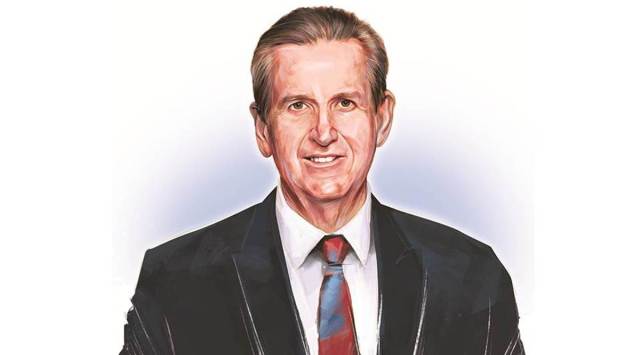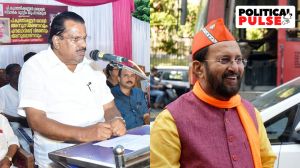- India
- International
Barry O’Farrell: ‘Power and wealth shifting from Atlantic… Quad not an Indo-Pacific UN… nations will determine own positions’
India, Australia, Japan and the US held their first Quad summit virtually on March 12. Barry O’Farrell, who completes his first year in office next month, is among the first diplomats to have presented his credentials virtually.
 Barry O’Farrell, Australia’s High Commissioner to India. (Illustration: Suvajit Dey)
Barry O’Farrell, Australia’s High Commissioner to India. (Illustration: Suvajit Dey)The Australian High Commissioner says China’s “change of attitude” created “extra incentive” for Quad, insists both countries are set to have “another go” at FTA, and explains why he is “impressed” with Prime Minister Modi’s reform agenda. The session was moderated by Deputy Chief of National Bureau Shubhajit Roy.
SHUBHAJIT ROY: How did the first Quad summit involving the US, India, Australia and Japan come about last month? It seemed to have come together quite quickly after US President Joe Biden took charge.
I think it came together pretty quickly after the inauguration (of Biden) for a variety of reasons. Clearly, the US administration wanted to make a statement about the Indo-Pacific region as part of its view of the world… I think the Quad, through our foreign secretaries and ministers, has proved itself increasingly useful over the previous two years. The Quad summit was a natural progression that occurred earlier this year, and it was not just about a change in administration in the US. I suspect it may well have occurred at some stage anyway. But certainly, we see the US administration being far more consistent and clear about its view around the Indo-Pacific, which matches the ambitions and aspirations of Japan, Australia, and of course, India in the region.
SHUBHAJIT ROY: Was China the glue that brought the Quad nations close?
I think the Quad was developed very nicely before China decided to change the way in which it interacted publicly with the world, and bilaterally with a number of nations. It is not that long ago that we had our foreign ministers’ meeting at the United Nations, and we have now had our first Quad meeting… It predates China’s changing posture. Power and wealth is shifting from the Atlantic to the Indo-Pacific. The Indian Ocean continues to be responsible for half of global trade, and it is important to each of the players in the Quad. China’s change of attitude in recent times probably has, to some extent, created an extra incentive, but I think the glue was there before.

NIRUPAMA SUBRAMANIAN: One of the underpinnings of the Quad is that it’s a coming together of four big democracies. The military coup in Myanmar has been a big challenge in the Indo-Pacific region recently. As a group, the Quad hasn’t said anything about it.
Firstly, I don’t think anyone has ever seen the Quad as an all-embracing Indo-Pacific parliament where there will be one attitude and one approach to issues that arise. Yes, we have a shared vision for the Indo-Pacific but that doesn’t mean we have a specific attitude to each and every country with whom most of us already have a relationship… When it comes to issues that will arise from time to time, including Myanmar, I’m happy to say that Australia has taken a strong position. But individual countries will determine their positions themselves. It is not an Indo-Pacific united nations…. I am not wishing to be in any way dismissive of the horrors that are occurring in Myanmar….
ANIL SASI: The negotiations between India and Australia on the Comprehensive Economic Cooperation Agreement (CECA) have been underway since 2011. Will there now be an attempt to revive it perhaps through more strategic tools or even the Quad?
Yes, our two countries tried to negotiate what is colloquially called a free trade agreement. We got well down the path and then it stalled. We are now in 2021. The good news is that both our prime ministers, on June 4 last year, agreed to reengage on CECA. That essentially means in the language of politics that we are about to have another go at it. That reflects the commitment from both sides to try and improve the trade and economic relationship between both countries, because we understand that it is commerce, investment, business that underpins both our economies and determines the living standards of our citizens.
A key part of the comprehensive strategic partnership was to promote trade investment between our countries and see opportunities in India, opportunities that have been opened up by reforms undertaken over the past 12 months, particularly around foreign direct investment… If India wants to have the world’s largest electric vehicle industry, if India wants to have a large battery industry, Australia has the critical minerals that it needs to develop those industries. And the good news is that some of those are already owned by Indian investors. The car world is looking for other opportunities to invest in similar sources of those minerals around the world, but equally in Australia.
SHUBHAJIT ROY: One of the sectors where India and Australia are planning to cooperate on is of rare earth minerals where the supply chains are overwhelmingly controlled by China. What is the progress on that front so far?
The work that India, Australia and Japan commenced late last year is progressing. The number one lesson of the pandemic is the need to not just have resilient supply chains but to have supply chains that are diversified. So that work is going on as we speak. In the meantime, Australia and India have both been doing work on scoping what we believe to be the demand for these critical minerals and rare earths in India.
I think the one thing that has evolved even more over this past 12 months is the level of trust between India and Australia. The first trade between Australia and India was in 1795, between Calcutta and Sydney… and we want to see more of it.
NIRUPAMA SUBRAMANIAN: If it’s not the business of the Quad to address what goes on in each individual country, what does the Quad have to offer to the people of the region? What does the Quad have to say to Myanmar?
At the end of the day, individual nations will determine their own attitudes on these issues. The Quad is standing up for the sovereignty of nations, and the rules and norms to encourage greater freedom and security across our region… The Quad leaders have made the point about the centrality of ASEAN and the ASEAN outlook in their work in relation to delivering a free, open, secure and a healthy Indo-Pacific.
SUNNY VERMA: The Indian government has been raising tariffs on a lot of items in line with the ‘vocal for local’ and self-reliant India campaigns to promote domestic manufacturing. What has been the position of Australian companies on this?
Of course, industries that are affected by changes in tariffs or non-tariff barriers will always raise those concerns with their government. But, over the past four months, I’ve been impressed by Prime Minister Modi’s reform agenda… From time to time, there will be, even amongst the closest of friends, the odd difference of opinion, and through the World Trade Organisation and other vehicles we peacefully, harmoniously, have to resolve that matters. I don’t think any nation is without issues that sometimes irk other countries. But I have to say, I’ve witnessed since I’ve been here over the past 13 months now, a closeness in the relationship with Australia. I have been coming here for 10 years, I have been a critic of the lack of consistency of the Australian government in their dealings with India. And at the risk of perhaps exciting some interest back home by this comment, I say, genuinely, that in Prime Minister (Scott) Morrison, in foreign minister (Marise Ann) Payne, and in our commerce minister, we have three individuals who have shown a constancy to this relationship. And I believe in any relationship, private, business or government, constancy is a key.
SHUBHAJIT ROY: How did Australia decide to take on China on issues linked to cyber capabilities? Also, was there any exchange of notes between India and Australia on this account?
In my view, it was the 5G decision made by Australia that made India look more closely at Australia (In 2018, Australia blacklisted both Huawei and ZTE from the country’s 5G ). I have known from my visits here that there was concern about the influence of your northern neighbour, our largest trading partner. The 5G decision demonstrated to India that Australia makes decisions based on its national interest, just as India makes decisions on its national interest… I don’t think the decision itself was surprising in that sense. But I think its impact in India has helped bring us closer over the past couple of years.
We know that whether it is AI (artificial intelligence), or these other technologies, they are going to change our world again, open up even more opportunities for citizens, for companies and for countries to do good, positive work. Equally though, they can be used for coercive and other purposes… We have talked about some of the cyber attacks that we’ve seen with some of the early versions of this technology. The rate at which this technology is evolving, we should be concerned about these things and all governments should be making decisions based on their national interest. The Australian government simply decided that we would not allow control over the system in Australia of what we believe to be a high-risk vendor environment. We need to ensure that when it comes to this technology, we can be confident about those who are operating it. I think that’s also leading to ongoing discussions between India and Australia and no doubt with other nations around the world, about the operating environment, because there are countries committed to an ecosystem that will ensure these things are used for good. We will be talking increasingly together to try and develop that ecosystem… On 5G and other initiatives we are taking to our friends, including India, about our experiences, because I’ve noticed that often other countries, including India, are able to avoid the pitfalls in areas where… other countries have gone first.
MANRAJ GREWAL SHARMA: Not many people know that Australia helped Punjab develop the happy seeder, which is a zero-tillage machine. Are we looking forward to more such initiatives?
I hadn’t heard of the happy seeder until six months before I came to India. When it was first mentioned to me by the Australian Centre for International Agricultural Research, which has been cooperating here in India for over 25 years, I immediately thought they were talking about Lebanese cedar trees… What the happy seeder does is to do away with the need to remove stubble. It harvests and replants in the same movement. Having been to Punjab a few months ago and having seen it in operation and been told about the way in which it is slowly but surely moving across agriculture in India, I’m pleased by that. We know that change is hard in any organisation. And it’s hardest of all, I suspect, in agriculture in India and Australia. But hopefully, there’s some progress… I think what it reflects is that mining a relationship is often not just about the import of products to India but also about the provision of technology, services and expertise to assist India to develop its markets. In agriculture, we’ve been working together on research projects like the happy seeder. I think one of the lessons out of the past four months, and this has been reinforced to me by technology experts, investors and governments, is that two of the hot areas where I think we are going to see this (collaboration) happening is education and telehealth… or the remote to use of technology for people who… may not be close to a hospital, or a clinic.
ANIL SASI: What is your opinion about the News Media Bargaining Code — the pushback from Facebook and the subsequent deal that was signed?
The code simply seeks to ensure that news organisations are fairly remunerated for the content that they generate through people like yourself (journalists). And it’s the basis of trying to help sustain a public interest journalism in Australia. And yes, like many other new policies, it took a while to get into a shape that met the government’s objective. But it did so in a way without overly interfering in the way in which businesses are able to operate. So we are comfortable with it. There has been considerable international interest in it. It’s clearly a fair thing to do. I know that the French had already gone down a slightly different path… India, like other countries, have an interest in our experience with the Bargaining Code, and we’d be happy to share insights with them as we continue to implement the code across Australia.
SHUBHAJIT ROY:You have watched federal structures and you understand centre-state relationships well. Currently, India is witnessing a second wave of Covid and there is a blame game going on between the Centre and states on the surge, vaccination….
The reason for that is that whilst it does and can create accurate media stories, whilst it can excite people and grab headlines, what I noticed here when I was having virtual conversations on the phone with various political figures at the state and Union level during the first six months of the last year was that so many of them said to me, ‘Ignore what you see in the newspapers on Covid. There is close cooperation between the Centre and the states.’ I’m talking here of state governments that are of a different political persuasion to the Centre. And I was heartened by that. Just as in Australia, I joke that for the first six months of Covid, I saw the Australian Federation work in a way that it had never worked before. It certainly didn’t work like that in a cooperative, constructive way, when I was the chief minister. But when the second wave struck Australia, we started to see a bit of a fracturing in the relationship between the individual states and the Centre. This is because people started to put their own state interests ahead of everything else. What’s currently happening in India in relation to the vaccine programme is extraordinary. The rate of rolling out of vaccines here in India, now over the past 14 days up until April 5, is 36 million doses… Australia is a country of 26 million people….
SHUBHAJIT ROY: In recent months, there have been a slew of arrests of climate activists and students in India. As a former politician do you think this augurs well for our democracy?
Firstly, it’s not for me or my government to comment on the internal matters of any country. But India is known rightly around the world for being a diverse and pluralistic democracy with robust and resilient institutions. In the last few months, a couple of reports came out calling some of that into question. But equally highlighting what is obvious as we speak — that India is a country where there are free, fair, and robustly fought elections… I think we have the same values. India has strong institutions that I think support the free and openness here… I’m not aware that any of the actions that have been going on in the time that I’ve been in India were not going on over the previous decade… I’m not aware of there being additional laws that might be described as coercive having been introduced to enable that to happen. So, in democracies, people elect governments. Ultimately in democracies, people will hold those governments to account. And in democracies, citizens look to the government to provide them with secure and stable environments in which they can get on with their lives. Part of being a democracy is the right to protest…
NIRUPAMA SUBRAMANIAN: Do India and Australia know each other any better beyond the three cliches of cricket, Commonwealth and curry? You have come up with the four Ds, which are dosti (friendship), defence, diaspora and democracy….
I think we have advanced because the size of the diaspora is now significant. One in 35 Australians are of Indian origin, either born in Australia or have a parent or grandparent who was born in India… Indians in Australia join us and participate in local communities and sports and the like. So that is people-to-people. Then at a business-to-business level, just as most US technology companies are run by people of Indian origin, we have similar experience in Australia. I think that has helped to open up the eyes of many in business in Australia to the opportunities that exist in this country. So yes, it (the relation) has progressed….
The thing that frustrates me is the media. Firstly, because of the economics of the media, there is only one Australian news representative in India. That means, therefore, when I read Australian newspapers… I am more likely to read articles… that have come from the The Guardian, The Wall Street Journal, The New York Times, The Washington Post written by, in many cases, people of Indian origin or citizens living in America or Britain… If Australian newspapers and media organisations can’t afford to have their own representatives in India, I’d like them to take copies from.
Indian journalists — the copies that are written every week, every day… This would further deepen and open up our eyes to the real India.
Apr 26: Latest News
- 01
- 02
- 03
- 04
- 05































